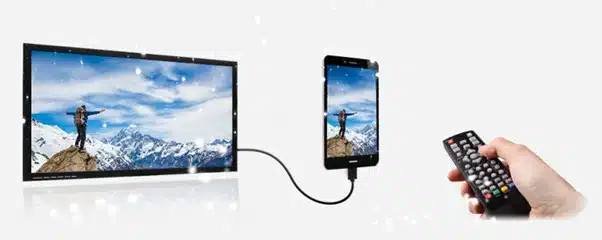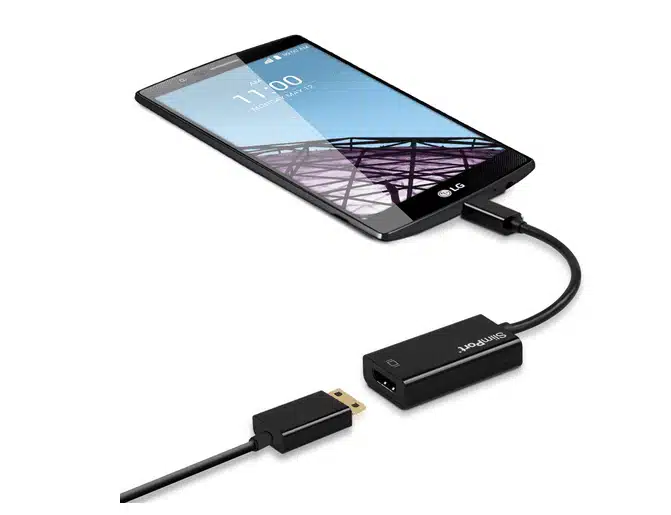Table of Contents
How to Connect Phone to TV With HDMI?
How To Connect Phone To TV With HDMI? Whether you’re sharing photos or watching a video, sometimes your phone’s screen just isn’t big enough. Fortunately, connecting your phone to a TV can easily remedy this problem.
First, locate the HDMI port(s) on your TV. HDMI ports are roughly trapezoid-shaped and will usually have the word “HDMI” printed next to them.
Connecting:
HDMI (High-Definition Multimedia Interface) is a common connector used to deliver video and audio signals between devices like phones, tablets, and TVs. It is also capable of supporting screen mirroring. If you have a newer Android phone, it probably has an HDMI port, but older models might only support the more basic MHL (Mobile High-Definition Link) technology. To connect your phone with HDMI, you will need an MHL-to-HDMI adapter or cable that has a micro-USB connector on one end and an HDMI connector on the other. Connect the Micro-USB end to your phone and the HDMI end to your TV.
Once the cable is connected, you can turn on your TV and use its remote or on-screen menu to change the input source to HDMI. Your phone’s screen should now be displayed on the TV.
If you’re using a newer Android phone that supports MHL, it may also have a USB-C port. This is a newer, more versatile connector that can transfer data, and power and support display output via different standards, including HDMI.
If you have an iPhone, you can connect your phone with an HDMI cable using a Lightning Digital AV Adapter. Connect one end of the cable to your TV’s free HDMI port – look for ports that have an HDMI label on them. Connect the other end of the adapter to your phone’s Lightning connector. Connect your iPhone to the adapter and turn on your TV. Use the TV’s source button or on-screen menu to select the HDMI input and start enjoying your content on a larger screen.
Enabling:
As long as the proper adapter and cables are in place, mirroring your phone to TV with HDMI is a straightforward process. For the best possible experience, ensure that your adapter’s data transfer capabilities match or exceed your TV’s HDMI port specifications. This will help you avoid hiccups while streaming high-resolution content, such as 4K videos.
To enable your Android smartphone to connect to your TV via HDMI, you’ll need a compatible cable and an adapter. Look for the USB connector on your device to determine what kind of cable will work best. Some smartphones use USB-C, which requires a special cable. Others use a standard micro-USB connector. If you’re using an HDMI cable, make sure that it’s long enough to accommodate the distance between your device and the TV.
Next, you’ll need to enable screen mirroring on your device. To do so, navigate to the settings menu and look for a setting that says something like “Screen Mirroring” or “Display.” Once you’ve enabled this feature, anything that appears on your phone’s display should also appear on the TV.
Once you’ve successfully connected your phone to the TV, you can enjoy a wide range of content. Whether you’re viewing family photos or relaxing with a movie, this connection method is easy and convenient. You’ll also be able to enjoy your favorite mobile games on a bigger screen.
Streaming:
Streaming the phone to the TV is an effective way to show presentations. And collaborate with coworkers on projects in real time. Or display photographs and videos for everyone taking part in a meeting remotely. It’s also an easy way to enjoy a movie or television series on a larger screen. It’s important to check compatibility and use the correct adapters and cables. As well as ensure the Wi-Fi connection is stable.
The most common method to connect the phone to the TV is with a wired HDMI cable. If you’re not sure whether your TV supports this, you can read its manual or visit its manufacturer’s website. It should list the types of ports it has and if any require an adapter. If you have a newer smartphone, look for a USB-C port. Many recent-model Android phones have this port and support HDMI output. For example, this feature is available on Samsung Galaxy S and Note smartphones. (Beginning with the S8), LG V and G smartphones, OnePlus phones, and Sony Xperia smartphones.
Connect the USB-C end of an HDMI adapter or cable to your phone’s USB-C port. And the other end to your TV’s HDMI port. Using your TV remote control or on-screen menu, set the TV to the HDMI. Input source that matches the port you connected the cable to.
Troubleshooting:
One of the simplest ways to connect your phone to your TV is with an HDMI cable. This method is not as fast as a wireless connection but is often cheaper and more reliable. It can also be used for screen mirroring, casting, and other video output methods. There are two types of HDMI connectors: the standard HDMI port on many TVs and the USB-C port on most newer phones.
If your device is not showing up on the TV, there could be a problem with the HDMI connection. The first step is to turn off the connected device and the TV. Unplug the power cords from both devices and allow them to remain unplugged for 30 seconds. Then plug the power cords back in.
Another common issue is that the HDMI handshake process fails. This is when the HDMI signal fails to establish a channel for communication between devices. This is usually caused by an incorrect EDID setting. Using the process of elimination, try changing the EDID settings to a different value until you see a picture on the TV.
If your phone is not showing up on the TV, you can also try disabling the USB Booster or Display Booster on your computer. These settings can cause problems with the HDMI connection. In addition, you should also check your video resolution settings. If the setting is on AUTO, you should reset it to match the built-in resolution of your TV or video projector.






Add comment